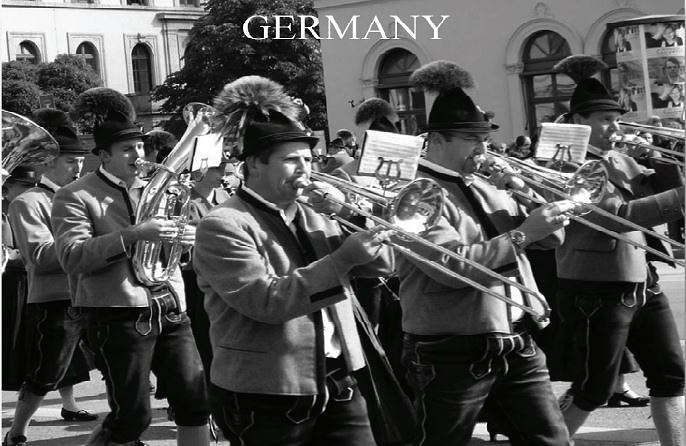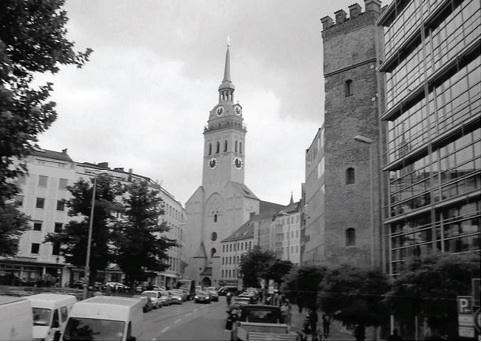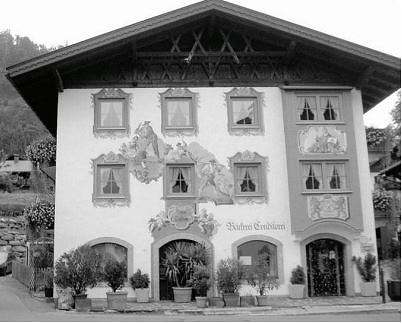
September 2008
During unusually warm 80º F weather in mid-September, in sandals and short sleeves, I flew from Boston to Munich to visit my cousin Turan and his wife Hanna. The next morning the greenery of the vast Bavarian plains welcomed us as we descended to Munich Airport. The outskirts of the city, lying among thick forests, emerged in the early morning light, albeit in unusually chilly 40º weather. My body struggled to adjust to the drastic weather change while I put on many layers of clothing. The heat felt good as I entered my hosts’ house. After napping for a couple of hours to make up for the six-hour time difference, I was ready to explore.
Our excursion started nearby, since my hosts live in the Nymphenburg region, home to the summer palace of the Bavarian Electorate from 1675 to 1806, and of the Bavarian Kings, who ruled until 1918. The Nymphenburg Palace and the adjoining park, which has an attractive canal with swans and ducks, transported me to an era far removed from the hustle and bustle of modern times. The royal buildings, surrounding a formal garden, were landscaped with flowers and ornate statues of mythical figures on pedestals. Silk wall coverings inspired by Chinese paintings enhanced the luxurious interiors of the complex, which included a Turkish bath. The porcelain shop featured exquisite objects.
The following morning I took a Hop-On Hop-Off tour to discover Munich from a double-decker bus. My hour-long tour, the Express Circle, showed the highlights of the city, starting off at the Hauptbahnhof (Main Train Station). We passed by the Pinakotheken (Painting Galleries), and stopped at Max-Joseph-Platz to view the National Theater built by King Max Joseph. The facade of the theater is adorned with a mosaic of Pegasus, symbolizing art and literature; a statue of the king sits in front. Passing through an exclusive shopping street, Maximillian Strasse, we continued to Marienplatz, a cobblestoned square closed to traffic and the center of the city’s social life.
To the left of the square is a 15th-century Gothic cathedral, the Frauenkirche, which is the trademark of Munich, with its unadorned but magnificent two towers with green domes. To the right is the late Gothic Neues Rathaus (New Town Hall) with its monumental Glockenspiel. Rhythmic sounds of 43 bells tolled, spreading in waves, while colorful carillon figures dressed in traditional clothes and set in the balcony of the tower danced to the style of Munich folklore. Directly opposite the Rathaus, other highlights were the Alter Peter, the oldest church in Munich, and the new Jewish Synagogue and Cultural Center. Our final stop before returning to the train station was in Stachus, the pedestrian shopping zone.
Munich is Germany’s third largest city after Berlin and Hamburg, with a population of 1.4 million. Since its beginnings as a market and trading village in 1158, it has gone through destruction and expansive change, with each succeeding era leaving an imprint on the city’s skyline. It is a city of fanciful baroque and playful rococo architecture, mingled with Gothic towers, as well as buildings modeled on classical Greek temples and built during the time of King Ludwig I, in the 1830s and 40s.
The neoclassical buildings on Königsplatz reflect the king’s enthusiasm for classical antiquity; his passion for art turned Munich into an art center of European renown, a status which it retains to this day. The Pinakotheken galleries house paintings by many of the Old Masters, while the Glypthothek has a great collection of classical sculpture. The Residence Museum contains the art collections and treasures of the city’s various rulers.
The Olympic Games in 1972 contributed modern forms to the city’s skyline. The Olympic Stadium with its roof network and the Olympic television tower are monuments to the 20th century. So are the “four-cylinder” BMW headquarters in the vicinity of the Olympic Stadium. The cylinders were mounted onto the core of the building and then lifted into position. Currently Mercedes is building a new monument to the 21st century.
The Lenbachhaus and the Pinakothek der Moderne are two institutions that attract artists and scholars to Munich as a fine arts center. The latter houses four museums under one roof — art, works on paper, architecture, and design. The museum is one of the world’s largest buildings housing art of the 20th and 21st centuries. In addition to permanent collections, it features temporary exhibitions in all four areas.
The international reputation of the Lenbachhaus, a villa that was formerly the residence of painter Franz von Lenbach, is based on its unique collection of works by the Blauer Reiter (Blue Rider) group, who split from traditionalists to promote a multiplicity of expressions, as opposed to a particular form of objective art, at the turn of the 20th century. The city owns the Tuscan-inspired villa with its major collections, donated by von Lenbach’s widow, as well as painter Gabriele Munter’s collection of oil paintings, watercolors, drawings, and sketchbooks by her longtime companion, Vassily Kandinsky. In addition, the galleries feature works by 19th and 20th-century artists, thanks to the city’s substantial acquisition budget, which extends to contemporary art. A replica of Franz Marc’s “Blue Horse” graces the underground metro station near the museum.

Downtown Munich
Munich’s local charm goes well beyond its art and architecture. The calm and leisurely Bavarian way of life, including eating and drinking well, means that the city is permeated with beer gardens, cafes, and places to eat. Schwabing is an attractive district full of elegant boutiques and galleries.
We had a refreshment break in an outdoor cafe, which offered red blankets to keep the autumn chill away. Our gastronomic highlights included a walk through the Dallmayr, an old coffee processing factory turned into a multi-story luxury delicatessen; the Viktualienmarkt or outdoor produce market; and the city’s famed beer hall, the Augustiner Brau. The variety of pastries at Café Sienna on the top floor of the Kustermann department store was a treat for both eyes and mouth. The apple cake with poppy seeds served with cream was delicious.
It was a wonderful coincidence to be in Munich during Oktoberfest, the city’s famed festival welcoming autumn. Started in 1810 in honor of the marriage of Bavarian Crown Prince Ludwig to Princess Therese, the festival was prolonged in following years and moved forward for better weather. Now the two-week festival takes place in the latter part of September and swells the city’s population to over 6 million. Huge tents are pitched on the Theresienwiese (Therese’s Meadow). The mayor of Munich taps the first keg of beer to open the festival.
On opening day Bavarians wearing traditional costumes filled the streets; many others came from out of town to take part in the festivities. The inner city was cordoned off and devoted entirely to the festival parade. I was able to squeeze my way through dense rows of spectators to take photos of some of the multiethnic groups and bands as they went by. Afterwards we enjoyed beer, served in one-liter steins, along with sausage and potatoes in a downtown restaurant. Unfortunately, due to heavy demand, they had run out of Weißwurst (white sausage), a local favorite served with a special sweet mustard.
Beyond Munich, mountains and lakes add to Bavaria’s international popularity. Its picturesque towns amidst woods and lakes contribute to the unique local color of the countryside. The Alpine foothills are within driving distance of the city and offer panoramic scenery of lakes and mountains dotted with charming towns. Our first drive was an afternoon excursion to Starnberg on the Starnberger See (Lake Starnberg), 20 kilometers south of Munich. On the way there, we passed by Tutzing, where Brahms composed three pieces. A stone relief of the composer’s head sits in the shade of a tree by the road.
Chilly fall weather had already descended over the lake, as evidenced by the many covered sailboats. Bundled up, we walked by the water’s edge, admiring the multi-hued foothills in the distance. We visited a church sited high in the meadow overlooking the lake. The whitewashed church, with an onion-domed tower, a well groomed cemetery, and cows grazing nearby, made beautiful scenery. Our next stop was another lake, the Ammersee. A passenger steamboat, churning its side wheels slowly, approached the landing at the town of Herrsching. A beautiful castle nearby beckoned for attention. We stopped in a specialty shop, where I was introduced to Renke, a local white fish, which is customarily eaten smoked. Naturally our dinner that evening featured smoked Renke.
An excursion to the Glentleiten Open Air Museum, high above Lake Kochel, introduced us to the way people in the area lived 100-200 years ago. 50 original homes from Upper Bavaria have been transferred here over an area of 25 hectares, where farmers drove their animals to pasture in summer. Wooden houses with shingle roofs and picket fences showed the dwellings of farmers, day laborers, craftsmen, or miners. The picturesque shingle roofs, held down by rows of rocks to hold back snow, were a reminder of the harsh winters. In addition to coal or wood-burning ceramic stoves, the severity of everyday life was demonstrated by stables, barns, granaries, and baking and drying houses.
Traditional landscapes included large watermills which activated a whetstone to grind grain, horses and oxen to pull the harvest wagons, cows to give milk for butter and cheese, and sheep to produce wool for clothing. Smiths and whetstone makers engaged in strenuous labor, while artisans demonstrated the traditional crafts of lace making and pottery. I purchased a handmade ceramic plate with a center motif of three fish, but resisted the grocery and bake shop. The museum’s restaurant, with flowers bursting out of balcony flower pots and its beer garden, made a lovely photo.
From the heights of Glentleiten, we descended to Lake Kochel to visit the Franz Marc Museum in Murnau, a market town in the Alpine foothills of Bavaria. Attracted by the vibrant light of the area, Marc came here to paint and was later joined by Kandinsky, Munter, Jawlenski, and Werefkin. They painted together here and became a focus of innovation, leading up to the Blue Rider movement from 1908 to 1914. Simplified forms with black outlines characterized their bold graphic-style painting. They rejoiced in painting flat areas filled with explosive, brilliant colors. Marc died in Verdun in the war in 1916. His house is now a museum with a terrace for coffee.
On the drive south toward the Austrian border, the light over the lake and mountains was indeed spectacular. After several stops to enjoy the scenery, we finally arrived in Garmisch late in the day. This was yet another charming mountain town. Hanna asked a local passer-by to recommend a good restaurant. Following directions, we drove uphill to a restaurant called Panorama, which was also a hotel. The view from its deck of the surrounding hills definitely fit the name. Unfortunately, it was getting dark and it was too cool to sit outside. We settled for an indoor table with a window view, to gaze at the flickering lights below. I ordered the local trout, served with almond butter. It was delicious.
A day excursion north of Munich to Regensburg was a rewarding discovery. Along the scenic drive were many fields of harvested hops plants, signaling we were in beer country. Hanna spotted a wreath shop off the road. We took a detour for a visit and learned about a variety of wreaths, including those made from hops. I bought a small wreath made of a plant which grows in the wild but was unknown to me. It has fragile-looking bulbous flowers, deep orange in color. I hand-carried it to Turkey, knowing it would not have a chance going through US customs.
Regensburg, whose name means “Rain Castle,” is an old city on the River Danube. The city is an open museum of historic buildings within walking distance of each other. The stone bridge over the Danube was constructed between 1135 and 1146. We had lunch at the Wurstkuchl, which claims to be the world’s oldest sausage house. Located near the stone bridge, it has been in business for over 500 years. I had Nürnberger Bratwurst (Nurnberg sausage), which consists of many small sausages served traditionally with sweet mustard and sauerkraut.
The Gothic Saint Peter’s Cathedral dominates the Regensburg skyline. Dom Platz (Cathedral Square) is the center of the city’s social life, with many outdoor cafes. Off the Cathedral cloisters is the All Saints Chapel. Other landmarks include Portal Praetoria, a gate in the Roman wall; the Romanesque Saint Ulrich’s Church; the 13th-century Baunberger Tower; the Goliath House with outside frescoes, built in 1573; and the Old Town Hall, where the Perpetual Diet (Parliament) met from 1663-1806. The Thon-Dittmer House is a patrician residence with Renaissance courtyard, and the Regensburg Theater is a venue for operas and plays. Among the buildings that stand out architecturally are the Church of the Dominicans, the Gothic Basilica with its columns, and the Palace of the Prince of Thurn und Taxis, as well as a royal villa built for King Maximillian of Bavaria. Pastel-colored town houses with zigzag rooflines delight the eye at the Arnulfsplatz, not to mention the many beautiful houses along the Danube River.
My five days in Bavaria were an insight into southern Germany, distinctive in local color, culture, and natural beauty.

Traditional Alpine house
